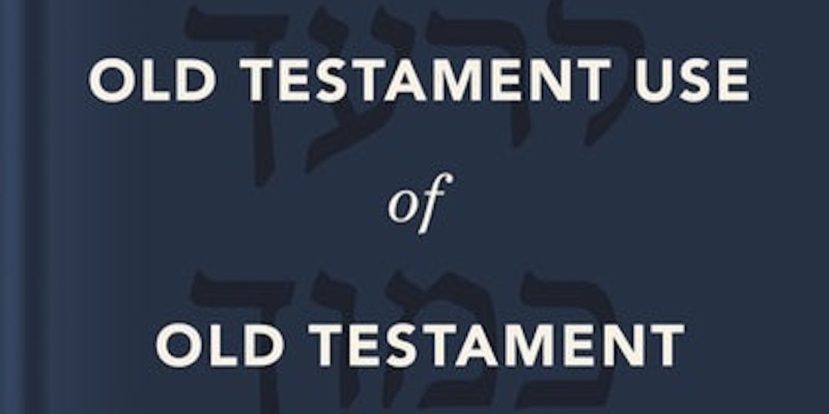
Surprises of Old Testament Use of Old Testament: Part 5
This post concludes this series with another surprise that came out of researching and writing a reference work for students and ministers of the word on the use of scripture within Israel’s scriptures entitled Old Testament Use of Old Testament.[1]. (See parts one, two, three, and four).
Unexpected Observation Five: Well-known Teachings as Culminations of Exegesis within Scripture
A large number of the favorite scriptural passages cited often within the Old and New Testaments—favorites of the biblical authors—are themselves cases of exegetical advancement within Israel’s scriptures. Interpreters often begin with the biblical authors’ favorite passages. But, in many cases, something else comes first. The research for this project forced me to dig deeper. What surprised me is that many favorite passages are not beginnings but are themselves culminations of exegetical advances within Israel’s scriptures.
Cherished passages like the blessing of Judah, the attribute formula in Exodus 34, the ten commandments in Deuteronomy, the song of Moses in Deuteronomy 32, the Davidic covenant, the last servant song in Isaiah 53, the new covenant of Jeremiah, and many psalms feature exegetical advances of revelation within them.[2] These passages, and a large number of others, are rightly considered revelation in their own right. But they did not simply drop out of the heavens. These scriptures enjoy deep continuity within the progressive revelation of Yahweh’s will by means of exegetical advancements of scripture. One example will need to suffice for the present purposes.
The commandment to love thy neighbor stands as the culmination of a multistage set of exegetical advances within the Torah. Since I have treated the details elsewhere, I will here only get at the punchline.[3] Below some of the elements compared may seem like common phrases in scripture. Some are. But they are only used in this way in the passages cited here.
Many biblical laws are not simply “because I said so” but come with explanations and motivations. Yahweh’s will for Israel often comes with built-in rationales that help connect the laws.
Yahweh’s will for Israel often comes with built-in rationales that help connect the laws. Share on XThe covenant collection of laws in Exodus 21–23 includes rationales and motivations for the protected triad of widows, orphans, and residing foreigners. Leviticus 19:33–34 takes the next step beyond protections to loving the residing foreigner as oneself. The evidence in this context demonstrates that this exegetical deduction comes by means of reading one scriptural context in the light of another. If the circumcised residing foreigner is “like” unto the native-born of Israel at Passover, then protection from oppression is not enough. Israel must treat them like the native-born.
The two-step exegetical advancement, first, from prohibition against oppression to admonition to treat them like us, and second, from love them to love thy neighbor can be observed then explained. Notice the way Leviticus 19:33–34 reads together two laws from Exodus and then notice how Leviticus 19:18b takes the next step (emphases signify verbal and syntactical parallels in Hebrew).
When a residing foreigner residing among you who wants to celebrate Passover to Yahweh must have all the males in his household circumcised; then he may take part as a native-born of the land. No uncircumcised male may eat it (Exod 12:48 lit.).
Do not mistreat or oppress a residing foreigner, for you were residing foreigners in the land of Egypt (22:21 lit.).
When a residing foreigner resides among you in your land, do not mistreat them. The residing foreigner residing among you must be treated as your native-born. Love them as yourself, for you were residing foreigners in Egypt. I am Yahweh your God (Lev 19:33–34 lit.).
Love your neighbor as yourself. I am Yahweh (Lev 19:18b lit.).
The protection of residing foreigners in the covenant collection is based on Israel’s experiential knowledge of being the oppressed outsider in Egypt (Exod 22:21). But the absence of oppression does not go far enough for residing foreigners who participate in Passover on the analogy of native-born Israel—they are “as” or “like” the native-born (12:48). Leviticus 19:33–34 brings these together to exegetically deduce the positive counterpart. The command extends the ideals of Passover worship to a general principle. Israel must love the residing foreigner like any other Israelite. The new law of loving them builds on the same rationales as the donor contexts in Exodus. Israel knows exactly what it means to be the outsider. That fund of experiential knowledge as outsiders needs to translate into how Israel treats the other among them.
The next step is relatively easy logic but with profound implications. Many biblical teachings work from the lesser to the greater. So too here. If Israel must treat the other like a native-born, then they must certainly treat native-born Israel at the same level.
What should not be missed is that love thy neighbor starts with Yahweh’s redemption of Israel. The motive for loving the outsiders does not begin with humanistic impulse. It begins with Yahweh’s redemption of Israel (Lev 19:34). Redemption motivates love of the other. Love of the other necessitates love of neighbor.
What should not be missed is that love thy neighbor starts with Yahweh’s redemption of Israel. Share on XIn sum, if love thy neighbor offers a summation of the whole law,[4] it also comes out of exegetical advances of revelation within Torah. Love thy neighbor did not drop out of the clear blue heavens. Instead this famed law stands as a culmination of a series of exegetical advances of revelation within Torah. Love thy neighbor begins with Yahweh’s redemption of Israel when they were the residing foreigner in a land of oppression.
Love thy neighbor is a culmination of a stream of revelation within Torah but only represents a penultimate highpoint within the Christian Bible. The sequel, namely, Messiah’s riddle of the good Samaritan takes the next step of progressive revelation by means of exegetical advancement.[5]
Summing Up
Continuing to ignore exegetical interconnections within the Old Testament will continue to impoverish New Testament and theological studies. Attending to the Old Testament use of scripture does more than explain what is going on in Israel’s scriptures. Learning how the Old Testament interprets Old Testament reconnects the New Testament use of scripture that greatly depends upon it. Likewise studying connections by means of scriptural exegesis of scripture enriches theological studies by laying bare the natural continuities of doctrine.[6]
Footnotes
[1] See Gary Edward Schnittjer, Old Testament Use of Old Testament (Grand Rapids: Zondervan Academic, at press).
[2] See Gen 49:8–12; Exod 34:6–7; Deut 5; 32:10–11; 2 Sam 14–15; Isa 53:10; Jer 31:31–34.
[3] See Schnittjer, OT Use of OT, note on Lev 19:18b, 33–34.
[4] See Gal 5:14; Rom 13:8–10.
[5] See Luke 10:36–37.
[6] Thank you to Jonathan Master and Keith Plummer for feedback on a rough draft of this series of posts.

